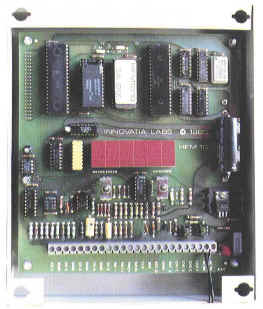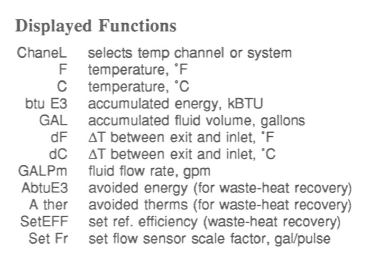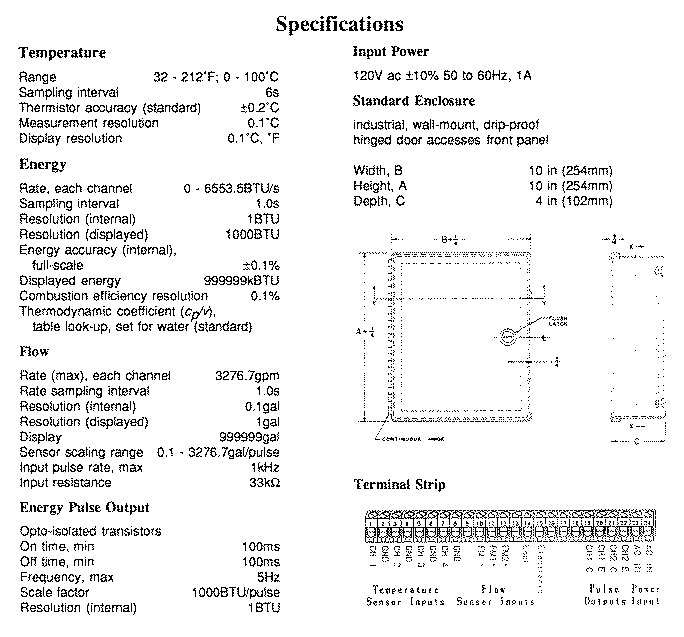

Thermal Energy Meter
 The HFM11 is a miniDAS-based commercial-grade thermal energy meter (or BTU meter) capable of measuring heat flows
through devices such as hot water heaters, heat exchangers, waste-heat recovery units, desuperheaters, or
solar heating systems. Where heat is added to or taken from a fluid, the energy meter can measure the amount of heat exchanged. Heat is
measured by connecting temperature sensors to the fluid inlet and exit pipes and by inserting
a volumetric fluid flow sensor in either the inlet or exit pipe. The meter measures the fluid temperature difference between
the inlet and exit and multiplies it by the fluid flow rate and a thermodynamic coefficient. The result is the energy flow rate. This rate
is accumulated as the total heat flow.
The HFM11 is a miniDAS-based commercial-grade thermal energy meter (or BTU meter) capable of measuring heat flows
through devices such as hot water heaters, heat exchangers, waste-heat recovery units, desuperheaters, or
solar heating systems. Where heat is added to or taken from a fluid, the energy meter can measure the amount of heat exchanged. Heat is
measured by connecting temperature sensors to the fluid inlet and exit pipes and by inserting
a volumetric fluid flow sensor in either the inlet or exit pipe. The meter measures the fluid temperature difference between
the inlet and exit and multiplies it by the fluid flow rate and a thermodynamic coefficient. The result is the energy flow rate. This rate
is accumulated as the total heat flow.
This meter has two energy measurement systems. It uses temperature inputs 1 and 2 for the first system and
inputs 3 and 4 for the second. Similarly, flow sensor input 1 is used by the first system and input 2 by the
second. The terminal connectors for these sensor inputs are together in one terminal strip at the lower end of the
circuit-board.
The single-board, 6502-based dual thermal energy
meter has a menu-driven, Innovatia-style user interface. This front-panel consists of two two-way switches (that can be pushed
either up or down) and a six-digit LED display. The switch-mouse (4 switches: MENU (Esc), Enter, Up, Down) runs the
menu tree on the display and numeric entry. The meter provides a menu of different functions that can be selected for displaying
quantities (such as total accumulated heat) or setting parameters (such as flow sensor scale factors).
 When installed and operating, the meter samples the four temperatures
once every six seconds and the flows every second. It then calculates the amount of heat that flowed by in the fluid that second and adds it to the
When installed and operating, the meter samples the four temperatures
once every six seconds and the flows every second. It then calculates the amount of heat that flowed by in the fluid that second and adds it to the
accumulated total. Also, the total volume of fluid is updated. During operation, several different system quantities (such as fluid flow rate or
temperature differences) can be monitored without affecting heat or fluid volume accumulation.
While the meter is operating, it sends pulses out the datalogging outputs, one for each energy system. These can be sent directly to most data
recorders or to a computer with a compatible interface.
This meter is auto-calibrating. Every six seconds it spends two of them calibrating itself against frequency and resistance standards on the circuit-board. These standards are accurate for the life of the instrument and
eliminate costly periodic calibration or accuracy degradation between calibrations.

Thermal Energy Meter Designware
This is a limited-edition item because the discrete 6502-based design is generally considered obsolete. Assistants can, however, save much effort in porting the meter, or functions of it, to another microcontroller from the existing designware.
The dual thermal energy meter designware includes:
|
Manual containing chapters on: |
1 Introduction
2 Installation
3 Operating Instructions
4 Specifications
5 Theory of Operation
6 Service Information
|
Schematic diagrams | |
|
EPROM firmware files, for English and metric energy units, and for desuperheater applications | |
|
Applications notes |
Several LE product units are available for $350 each. Three are in NEMA1 (drip-proof) enclosures for outdoor installation for $400.
This is not an active Innovatia project. The HFM11 has been modified to become the miniDAS which is used only in Limited Edition prototype units of other instruments. The HFM11 Manual is available to Innovatia Assistants.
HFM11 Designware is also available.
![]()